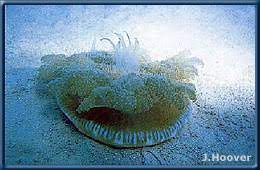
Upside-Down Jellyfish of the genus Cassiopea are a a complex of many, widely distributed species in tropical and subtropical waters. They typically lie on their flat bells, in shallow bays and lagoons, often near mangroves, with their eight oral lobes projecitng upwards into the water. They occasionally turn 'right-side up' and swim in typical medusa fashion, and are well-known for stinging waders and swimmers. Adults of C. andromeda can reach a bell-diameter of ~210 mm, but are more typically around 100 mm. The oral arms arise from a disc about one-third the size of the bell, bearing five or more leaf-like appendages. The oral arms are about equal to the radius of the bell, and bear numerous lateral appendages, armed with numerous mouthlets and and nematocysts. Cassiopea captures and ingests zooplankton with its oral arms, but also receives much of its nutrition from symbiotic dinoflagellates (zooxanthellae). Colors of the medusae vary with the species of zooxanthellae- specimens from Sri Lanka range from white to brown to purple (Karunarathne et al. 2020).
The genus Cassiopea consists of many species, many of which are undescribed. The morphology is variable, making molecular identification necessary. Cassiopea andromeda was described from the Red Sea in 1776, and is widespread in the Indo-Pacific for, the Red Sea, the Indian Ocean, the Philippines, Indonesia, northeast Australia, and French Polynesia. However, many records, without genetic identification, may be sibling species. Cassiopea andomeda also appear to be prone to blooms, long disappearances, and sudden outbreaks. Cassiopea andomeda entered the Mediterranean Sea though the Suez Canal by 1886, reaching Cyprus by 1904, and Sicily by 2014. Cassopea andromeda reached Hawaii by 1945, probably from the Philippines. In the Atlantic, molecular methods are needed to distinguish it from the native Western Atlantic C. xamachana, However, Cassipea andromeda was identiifed by molecular methods in Brazil in 1999, in Bermuda in 2004, and in Key Largo, Florida, in 2021, In Florida, C. andromeda was found largely in marinas, and constitued aut 17% of the Cassiopea found (Muffett and Miglietta 2023), The scyphistomae (polyps) of C. andromeda can be transported in fouling. Planula larvae and medusae can be transported in ballast water, Scyphistoma polyps of C, andromeda have been found on 'live rock', pieces of coral sold to decorate aquariums, and this jellyfish has also been imported for biological research. The extent of Cassiopea andromeda in the Western Atlantic is not fully known,